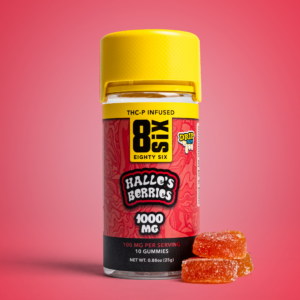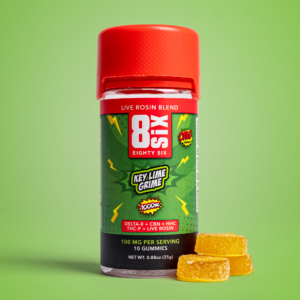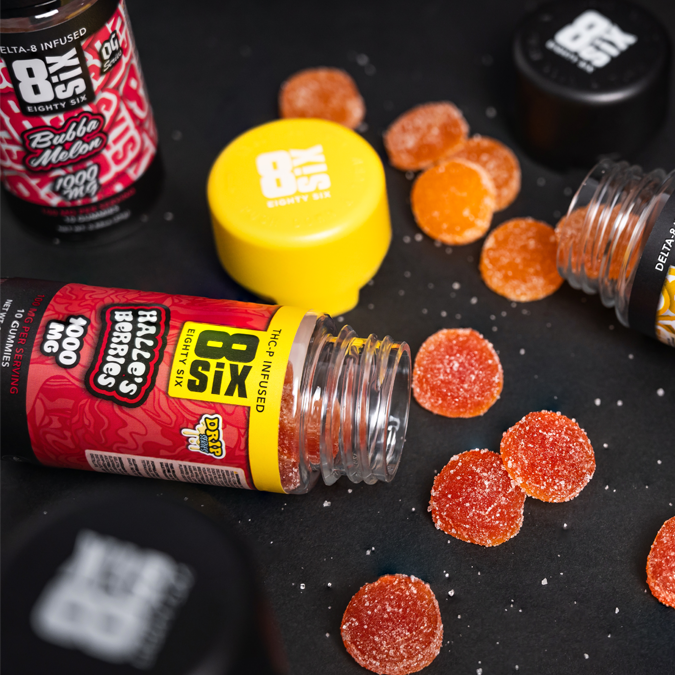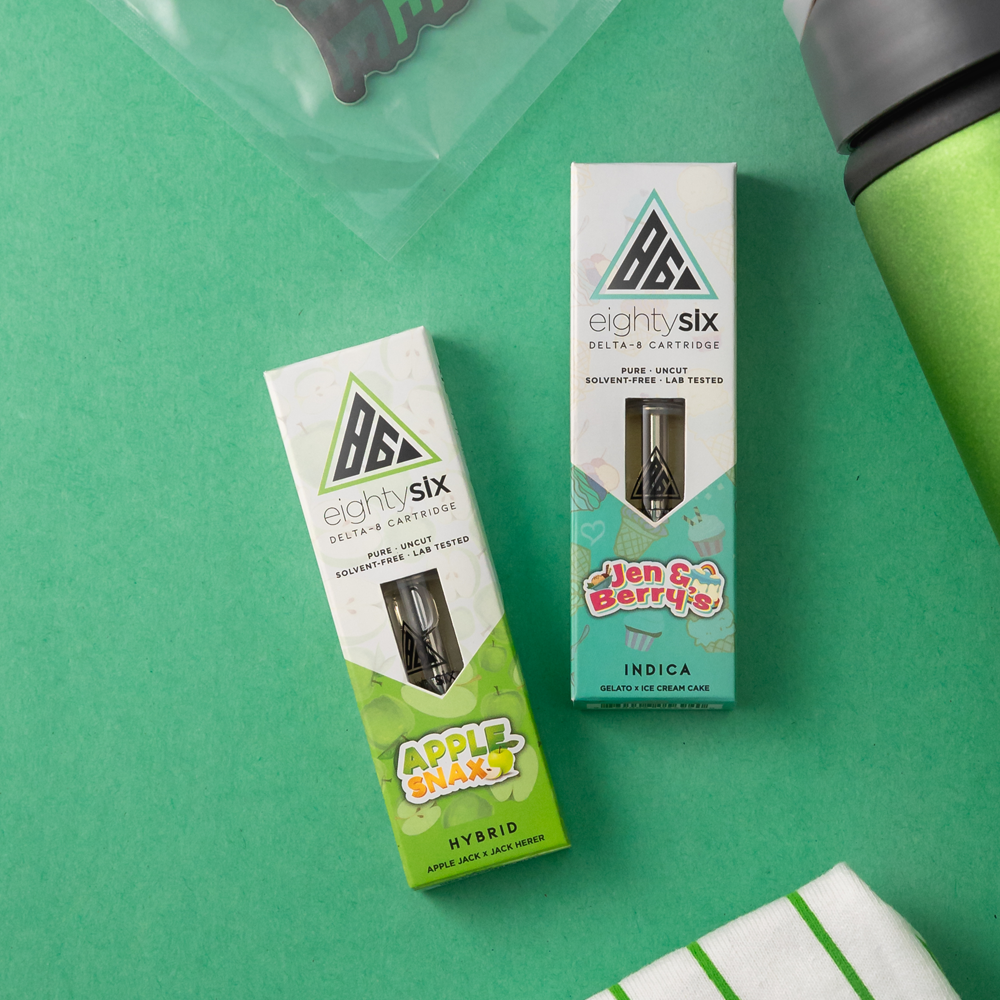With the new release of our Live Rosin Blend Gummies, it’s important to know the difference between these and our regular offerings of single-cannabinoid gummies. In this article, we’ll be going into detail on what to expect from a complex blend of several cannabinoids further enhanced with live rosin to deliver a true-to-strain edibles experience.
What are Distillate Gummies?
-
Product on sale
 Midnight Melon 1000MG Delta-9 THC Gummies$14.99 – $119.99
Midnight Melon 1000MG Delta-9 THC Gummies$14.99 – $119.99 -
Product on sale
 Halle’s Berries 1000MG THC-P Gummies$19.99 – $159.99
Halle’s Berries 1000MG THC-P Gummies$19.99 – $159.99 -
Product on sale
 Tropical Sunset 1000MG Delta-8 THC Gummies$14.99 – $119.99
Tropical Sunset 1000MG Delta-8 THC Gummies$14.99 – $119.99
Regular distillate gummies are edibles that are infused with distilled cannabinoids. Distillate gummies have been on the market for a few years now, so they’re popular and familiar with users everywhere. If you live in a state where cannabis is still illegal, you may see gummies that are infused with different hemp-derived cannabinoids, which became federally legal in 2018 with the Farm Bill. You can find gummies infused with Delta-8, which is mildly psychoactive, Delta-9, which is highly psychoactive, or other less known cannabinoids such as HHC and THC-P.
What are Live Rosin Gummies?
Live rosin gummies are edibles that are infused with live rosin and a cocktail of multiple cannabinoids instead of single-cannabinoid distillate.
-
Product on sale
 Tangie Terror 1000MG Live Rosin Blend Gummies$9.99 – $119.99
Tangie Terror 1000MG Live Rosin Blend Gummies$9.99 – $119.99 -
Product on sale
 Key Lime Grime 1000MG Live Rosin Blend Gummies$9.99 – $119.99
Key Lime Grime 1000MG Live Rosin Blend Gummies$9.99 – $119.99 -
Product on sale
 PRPL Haze 1000MG Live Rosin Blend Gummies$9.99 – $119.99
PRPL Haze 1000MG Live Rosin Blend Gummies$9.99 – $119.99
What’s the Difference Between Live Rosin and Distillate?
Distillate is made through a complex process that involves soaking dried flower in a solvent to separate the cannabinoid of choice. Once the cannabinoid is separated from the plant, the solvent mixture, otherwise known as the mother liquor, is then distilled or purified repeatedly to remove small particles, the solvent itself, and other impurities. Unfortunately, the distilling process also removes some things we’d actually like to keep, such as terpenes and other cannabinoids. This one-track mind of a distillate eliminates the entourage effect that occurs when different terpenes and cannabinoids interact with each other in your body.
Live rosin on the other hand, is made in an entirely different extraction process. To start with, distillate is extracted from dried cannabis buds, while live rosin is extracted from freshly picked and then frozen buds. The drying process destroys a lot of the temperature sensitive terpenes in cannabis, whereas freezing freshly picked cannabis preserves many of the cannabinoids and terpenes. The other big difference between the extraction processes for distillate and live rosin is that distillate uses solvent to separate the THC from the plant, while live rosin uses a solventless process and relies on heat and pressure to separate THC – and all the other terps and cannabinoids – from the plant. The use of solvents in the extraction process removes even more of the good terps and cannabinoids you want to keep. Live rosin is typically extracted using a low heat setting, which also helps preserve the tasty terps and cannabinoids.
The difference between the two can really be felt in the effects of the final products. Distillate contain only THC, so while it’s potent, the high can sometimes be a little flat, especially when compared to the dynamic, synergistic effects from live rosin, which packs a bigger punch because it still contains so many of the other important terps and cannabinoids that distillate processes out.
The Common Terpenes Found in Live Rosin Gummies
What’s so special about terpenes anyway? Well, as it turns out, a lot actually. Terpenes are the chemical compounds that are responsible for how plants smell. Though terpenes are usually associated with cannabis, every plant-based scent, from lavender to citrus is created with a blend of terpenes. In nature, these plant scents help to protect the plants from bacteria and predators, but also work to our therapeutic benefit as well.
Limonene, Pinene, Linalool, Terpineol, and Myrcene are some of the most common terpenes in both marijuana and hemp, and, while they don’t get us high, each has a uniquely powerful effect associated to it. Studies have found Limonene to have anti-inflammatory, antioxidant, antiviral, antidiabetic, and anticancer effects as well as playing a role in regulating the behavior of immune cells, protecting the body from a variety of disorders.
Pinene, on the other hand, is a bronchodilator, allowing more air into the lungs as well as having anti-inflammatory effects.
Linalool is the dominant terpene found in lavender and has several therapeutic effects. Linalool has recently been found to have the potential to have a wide range of effects including anti-inflammatory, antimicrobial, antidepressant, anticancer, anxiolytic, and neuroprotective properties.
Studies have found myrcene may help protect the brain against oxidation after a stroke; while another study found it to have a similarly protective effect in heart tissue.
Terpineol has a delightfully refreshing aroma and provides a relaxing, calming effect and has antidepressant and neuroprotective properties.
What to Expect
Distillate gummies are a great experience, and many people love them, but live rosin gummies pack a much more powerful punch. Distillate gummies will get you high, but the psychoactive buzz can feel flat, where you have either a head high or a body high, but not both, and for more experienced stoners, the effects can start to wear off a bit more quickly. Live rosin on the other hand, can deliver the kind of effects you’d expect from smoking bud because so much of the plant profile is preserved. You’ll feel not only a powerful body high but a buzzy head high as well, creating a fuller body experience with effects that can last much longer than the effects of distillate. You can learn more about the nuanced differences between distillate gummies and live rosin gummies on the Eighty Six Blog.




